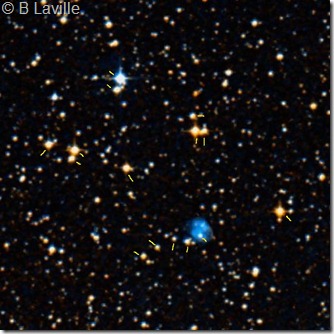|
Cet objet est enregistré sous la référence PGC 932285 car le catalogue LEDA est le seul qui le référencie (2012 12). Il a été étudié récemment par Mathias Kronberger:
Several weeks ago, during a survey of the outer Milky Way in Sagittarius, I came across a new and bright (!) obvious planetary nebula candidate in the vicinity of Barnard’s Galaxy NGC 6822. Coordinates are 19 37 43.77 -13 51 20, size is approx. 0.7’x0.45′. The appearance of the nebula on the (blue) DSS-I image suggests a mild bipolar morphology; the red DSS-II image shows also very faint outflows along the longer axis of the PN. Nothing in SIMBAD or NED. VIZIER shows a double entry of the object in the LEDA catalogue of Paturel et al. (LEDA 932285 and LEDA 932333) but the object is clearly a line emitter and not a pair of (interacting) galaxies. There is no IRAS or radio source present at this position; which is probably one of the reasons why the object has remained unnoticed until now. The PN candidate is only 1.5 degrees distant from NGC 6818 (2 degrees from NGC 6822) and easily found 6′ N of the 7 mag star SAO 162831.
I managed to observe the object last week with my new 15" under good transparency (ZLM ~ 6m,8 – 7m,0). Even without filter a very faint glow appeared at the position of the PN candidate. An OIII filter boosted the visibility of the object considerably and showed it as a roundish glow with approx. 20" size that could be held easily with averted vision. I also tried to see the two lobes individually but failed to do so, probably due the lack of contrast and the faintness of the object. The total brightness of the object I estimate to be ~15 mag, so it’s probably amongst the top three in terms of brightness amongst the DSH PN sample.

x240 Ethos 13mm/OIII-12nm
Franchement, je suis étonné: la NP est facile, bien détachée, vue VI1-VI2, nette. D ~ 25", pas de couleur.
La forme est ronde, mais pas parfaite: ce n’est pas un cercle, mais je ne peux déterminer une forme détaillée. Il m’a semblé, non sûr, un a/b ~ 1.10 en AP 150°. [Note 2012 12 18: cet AP est valable, mais uniquement pour les parties les plus lumineuses de la NP]
x519 Ethos 6mm sans filtre
Le champ est riche, et bien détaillable car étagé.
La CS* est perçue VI2-VI3, pas faible, mais pas limite.
A* est déjà vue avec 240/OIII !
En conclusion, c’est une observation surprenante de facilité. Je m’attendais à un challenge, je découvre une NP dont je me demande comment et pourquoi elle n’a pas été découverte plus tôt.
A* U3 153-337433, m16.3V, A2 0750 18641524, m14.5V
B* GSC 5735 1913, m11B, U3 153-337481, m10.7V, A2 0750 18646104, m11.4V
|
Laissez votre réponse !
Vous devez etre connecté pour poster un commentaire.